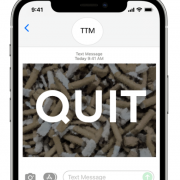Tobacco smoking is the leading preventable cause of death, globally. In 2019, approximately 14% of Australians aged 14 years or older were current smokers. That’s approximately 2.9 million Australians. On World No Tobacco Day,
Dr. Ryan Courtney and his team would like to highlight the importance of quit smoking research in low socioeconomic populations and provide details on an exciting new technology-based quit support study that begins recruitment in June 2022.
The disease burden and tobacco smoking in Australia
Tobacco smoking is the leading cause of preventable disease and death in Australia. In 2015-2016 it accounted for over 9% of the total disease burden, caused over 21,000 annual deaths and cost $136.9 billion in social costs per year.
Tobacco smoking and low-SES populations
In Australia, low-socioeconomic status (low-SES) populations are overrepresented among smokers and the socioeconomic gradient in smoking has persisted over time, despite current health efforts. A 2019 national survey found people from disadvantaged areas are over three and a half times more likely to smoke daily compared to those from most advantaged areas. With Australia failing to meet its 2009-Preventative Health Taskforce target of a 10%-or-lower smoking rate by 2020 it’s clear that increasing quit smoking rates in low-SES populations is important for Australia to meet future health targets and lower the burden of disease caused by tobacco smoking.
Current quit smoking services
Telephone cessation support (Quitlines) has been the backbone of cessation services in many countries. Whilst Quitlines are effective, they are often underutilised. A recent study found that only 3.2% of Australian smokers had ever used Quitline. Quit rates arising from telephone support use remain low among low-SES smokers, suggesting the need for a shift in treatment format and delivery. Recent qualitative studies have shown that various barriers such as guilt, shame and stigma prevented treatment seeking. Smokers also expressed greater receptivity to alternative support like text messaging.
Why text messaging?
Text messaging is a powerful and particularly well-suited tool to meet the requirements in delivering behavioural change interventions to low-SES populations, given its high reach, fidelity, availability, affordability, cultural adaptability, user acceptability, and scalability. Furthermore, text message programs can be easily shared and tailored to individual or more widespread needs. Despite all these benefits, no tailored text message program has been designed, tailored, or implemented for low-SES smokers.
Our program
Our team has built on previous quit smoking programs and utilised in-depth expert and consumer advisory group qualitative work to design a 12-month text message quit support program that is tailored to the individual needs of low-SES smokers. With over 11,000 potential individual sequences, our program is tailored based on 14 different topics including; daily cigarette consumption, urges, quit approach style, reasons for quitting, facilitators and triggers. 63 unique behavioural change techniques are utilised in the program that each combat a different behaviour, barrier or facilitator associated with quit smoking.
Our study
We aim to recruit 1,246 participants in our parallel, two-group, randomised controlled trial with the objective to determine the effectiveness and cost-effectiveness of our tailored text message program at achieving six-month continuous smoking abstinence compared to Quitline Services in low-SES daily smokers.
The takeaway message from this study
Our highly personalised program has the potential to transform the delivery of Australian and international tobacco smoking cessation interventions, and thus potentially shows promise for improved health and economic implications compared to the services currently available.
Where to find us
If you have any questions about this study, please contact Kieran Patel on Kieran.patel@unsw.edu.au.



